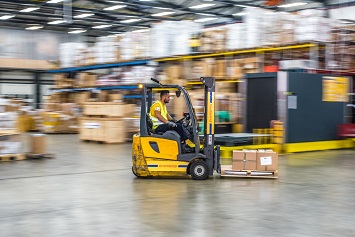It’s National Forklift Safety Day, sponsored by the Industrial Truck Association. Use this day to start, review, or update your forklift and pedestrian safety program.
A punch press operator at a computer components manufacturer was working at her workstation near an aisle used by forklifts. A forklift traveling in reverse accidently hit a metal scrap bin sitting next to the punch press, shoving the bin against the press and the worker, crushing her.
A 17-year old worker hitching a ride on the side of a forklift jumped off to open a gate before the lift was fully stopped. The rear tire caught the worker’s foot and rolled over his body as he fell, killing him.
These are examples of actual workplace incidents investigated by OSHA, or the Occupational Safety and Health Administration. Incidents like these can be prevented with safe work practices, training, and worksite controls that minimize the chances of contact between forklifts and pedestrians.
In this article we’ll look at some of the worksite controls many employers adopt that, combined with safe work practices and training, can significantly reduce the risk of collisions between forklifts and pedestrians.
Common Risk Factors for Pedestrian Incidents with Forklifts
In order to prevent forklift and pedestrian incidents, identify the hazards and risk factors that increase the probability of collisions between forklifts and pedestrians. For example, consider whether the following risk factors involved in many forklift incidents apply to your workplace:
- Blocked line of sight–one factor is blocked line of sight between the forklift operator and a pedestrian. It’s often hard for forklift operators to see pedestrians. The operator enclosure can create blind spots that limit an operator’s view just long enough to lead to a collision between a forklift and a pedestrian. A forklift operator may not be able to see directly behind when traveling in reverse. Pallets stacked with materials, storage structures at aisleway entrances or corners, or building columns and walls also contribute to the visibility problem.
- Pedestrians work too close to forklifts–another risk factor is workers doing work or their workstations are too close to forklift travel areas. The actual case of the press punch operator crushed by a metal parts bin described earlier is an example of a workstation too close to a forklift travel area.
- High-traffic forklift and pedestrian intersections–areas with high foot traffic intersecting with frequent forklift traffic increases the probability of contact between pedestrians and forklifts.
- Obstructions–aisleways with obstructions or debris can cause forklifts or pedestrians to change their travel patterns or get distracted, increasing the risk of incidents.
- Unauthorized passengers—workers or others riding on a forklift or the forks greatly increases the risk of injury to both the passenger and the operator, as illustrated in the case mentioned earlier.
- Poor housekeeping–poorly stacked or packaged loads, damaged pallets, drums, and bins can result in objects falling from forklift loads, increasing the risk of pedestrians getting hit by falling objects.
Think of other risk factors that could contribute to incidents between forklifts and pedestrians unique to your worksite.
Worksite Controls to Reduce Risk
There are worksite controls and measures designed to keep pedestrians safe when walking or working around forklifts. Implement the following risk-reduction measures and other site-specific controls in combination with safe work practices and training:
- Post danger or caution signs in key areas warn about forklift activity and hazards. Signs remind workers to stay well clear of lift trucks when they are in motion or loading or unloading.
- Equip forklifts with horns, warning lights, and backing-up alarms.
- Install convex mirrors at blind aisle intersections.
- Clearly mark pedestrian walkways that direct pedestrians to stay within designated walkways, and alert forklift operators to keep out of walkways.
- Install physical barriers where warning or cautions signs or marked walkways are inadequate to safely separate forklifts from people working or walking nearby.
- Establish exclusion zones or areas that are completely off-limits to pedestrians, and the same for areas off limits to forklifts.
- Develop a written traffic safety plan that outlines all the methods and procedures to ensure the safety of forklift operators, other workers, and visitors to the facility. Include a map of the worksite that illustrates traffic lanes and intersections where pedestrians and forklifts meet.
- Post signage and other notices in the workplace prohibiting workers and visitors from riding a forklift.
Who Has the Right-of-Way, a Forklift or Pedestrian?
Federal OSHA recommends that employers adopt a policy that forklift operators yield the right-of-way to pedestrians. OSHA’s rule for powered industrial trucks, which includes forklifts, makes no statement that forklift operators yield the right-of-way to pedestrians. It is a best practice. Responsibility for avoiding collisions is a two-way street. Operators may not see a pedestrian that suddenly appears turning a corner or crossing an aisle, leaving the operator with no time to stop. Remind pedestrians through training and workplace notices to stay alert for forklift activity in areas where they typically travel and obey warning and caution signs, especially in noisy areas where it may be difficult to recognize forklift horns and alarms.
Free Resource!
In honor of National Forklift Safety Day, a Forklift Driving Evaluation Form is available for download for free alongside a free trial of Safety.BLR.com.

